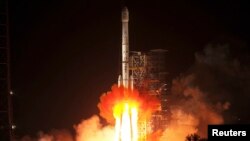China says the launch of its first ever robotic mission to the moon's surface has been a success
The Chang'e-3 lunar probe, which includes the "Jade Rabbit" rover buggy, blasted off early Monday from the Xichang Satellite Launch Center in China's southwestern Sichuan province.
The probe is scheduled to land on the moon in mid-December to explore its surface and look for natural resources. China aims to become only the third nation to carry out a lunar rover mission following ones from the United States and former Soviet Union decades earlier.
Morris Jones, an Australia-based independent Asia space analyst, says this mission is, in many ways, China's most ambitious.
"Landing on the moon is going to be tricky," Jones said. "The moon is fairly treacherous terrain. There is no pilot on board, and so it's going to take a lot of skill by the onboard computer to steer the vehicle to a safe landing."
This craft is expected to make a "soft" lunar landing, which was last accomplished by the Soviet Union in 1976. “Hard” crash landings are easier, and China crashed a craft into the moon in 2009.
President Xi Jinping has said he wants China to establish itself as a space superpower, and the mission has inspired widespread pride in China's growing technological prowess.
The RAND Corporation's Scott Harold said the space program underscores China's technological nationalism.
"It's definitely a part of the Chinese government's efforts to show that they are coming of age," Harold said. "They are really increasing their technological sophistication and they're playing on a very big stage."
Online reactions to the launch from the Chinese public were mixed, ranging from expressions of pride of country to criticism that the accomplishment was done without the consent of the people and did nothing to help clothe and feed the population.
Beijing aims to establish a permanent space station by 2020 and eventually send someone to the moon.
In 2007, China launched its first moon orbiter, the Chang'e-1 - named after a lunar goddess - which took images of the surface and analyzed the distribution of elements.
The Chang'e-3 lunar probe, which includes the "Jade Rabbit" rover buggy, blasted off early Monday from the Xichang Satellite Launch Center in China's southwestern Sichuan province.
The probe is scheduled to land on the moon in mid-December to explore its surface and look for natural resources. China aims to become only the third nation to carry out a lunar rover mission following ones from the United States and former Soviet Union decades earlier.
Morris Jones, an Australia-based independent Asia space analyst, says this mission is, in many ways, China's most ambitious.
"Landing on the moon is going to be tricky," Jones said. "The moon is fairly treacherous terrain. There is no pilot on board, and so it's going to take a lot of skill by the onboard computer to steer the vehicle to a safe landing."
This craft is expected to make a "soft" lunar landing, which was last accomplished by the Soviet Union in 1976. “Hard” crash landings are easier, and China crashed a craft into the moon in 2009.
President Xi Jinping has said he wants China to establish itself as a space superpower, and the mission has inspired widespread pride in China's growing technological prowess.
The RAND Corporation's Scott Harold said the space program underscores China's technological nationalism.
"It's definitely a part of the Chinese government's efforts to show that they are coming of age," Harold said. "They are really increasing their technological sophistication and they're playing on a very big stage."
Online reactions to the launch from the Chinese public were mixed, ranging from expressions of pride of country to criticism that the accomplishment was done without the consent of the people and did nothing to help clothe and feed the population.
Beijing aims to establish a permanent space station by 2020 and eventually send someone to the moon.
In 2007, China launched its first moon orbiter, the Chang'e-1 - named after a lunar goddess - which took images of the surface and analyzed the distribution of elements.








